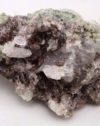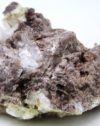 SCUTELLA (“SAND DOLLAR” FOSSIL)
SCUTELLA (“SAND DOLLAR” FOSSIL)
HISTORY, NAME, LOCALITIES: Scutella fossils have been known since prehistory, but were first scientifically described in 1829. The name stems from the Latin scutum, meaning “shield” and alluding to the rigid, chitin-calcite plates that made up the animal’s exoskeleton. Scutella fossils occur worldwide, mostly in Miocene Epoch sediments. Important collecting localities are in France, England, and the southeastern United States.
PALEOBIOLOGY, OCCURRENCE: Scutella fossils are the calcified remains of the exoskeletons of marine echinoderms, a phylum that includes starfish, crinoids, and sea urchins. The paleo-genus Scutella thrived during the Miocene Epoch some 20 to 12 million years ago. Scutella exoskeletons have a five-fold symmetry and consist largely of calcite and chitin, a nitrogenous organic compound. After burial in sediments that later lithified into limestone and sandstone, calcite replaced the chitin to preserve the exoskeleton as a durable fossil. Some fossilized Scutella are silicified or partially silicified, with microcrystalline quartz replacing the calcite. Scutella fossils and those of related genera are found worldwide, usually in matrices of calcareous sandstones.
METAPHYSICAL PROPERTIES, LORE: Scutella fossils are familiarly known as “sand dollars” for their disk- or coin-like shapes. Scutella fossils have been recovered from ancient tombs, and drill holes in some specimens indicate that they were worn as amulets or jewelry. Metaphysical practitioners believe that Scutella fossils promote bravery and inner strength, aid in decision-making, and foster success.
COLLECTORS’ INFORMATION: Because of their attractive, five-fold symmetry, age, and excellent detail, Scutella fossils are widely collected. Specimens are often “reliefed” by the partial removal of the sandstone matrix to better expose the fossils.




 Axinite #10
Axinite #10  Axinite #8
Axinite #8